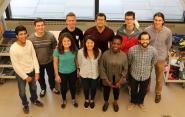2017 CEID Fellows Present Their Final Innovations

Members of the fifth cohort of the Yale School of Engineering & Applied Science's Summer Design Fellowship made their final presentations last week. The 10 students in residence at the Center for Engineering Innovation & Design comprised four teams, each working on a specific project for eight weeks. The Summer Design Fellowship is unique in that student teams are provided the resources to create hardware and software solutions for a specific problem, as opposed to working on previously established research projects. It is the only fellowship specifically designed to assist "makers" at Yale.
Variant Vision – With this project, Oyindamola Alliyu ’20 and Antonio Medina '19 developed a sensor worn with glasses designed to help people with visual impairments move around more freely.
“We wanted to use our skills, but put those skills to something that was useful,” Alliyu said.
The team envisions the product as supplementing the walking cane or guide dog, specifically to help the user avoid objects in the shoulder and head area. Part of their research included looking at what products are available on the market. They also worked with a former police officer who lost his sight several years ago.
“He invited us into his home and provided us a glimpse into his day-to-day life,” Medina said. “We wanted to create something that could increase confidence, independence and safety for blind people.”
Their product is pair of eyeglasses with an ultrasonic range finder about the size of a quarter. The sensor uses cones of sonic waves to detect nearby objects, and then notifies the user with vibrations. Alliyu and Medina said they expect to keep working on the product over the next year.
“We’re getting close to a design that someone can go out and grab, put it on, and it works,” Medina said.
Happy Feet - Lauren Chapey '20, a member of the Yale cross country team, knows of running injuries; six of her teammates suffered from them last season alone. Almost 80 percent of all runners get injured each year and half are recurring. She and Joyce Duan '20, and Ethan O’Reilly '20 teamed up to create a device addressing that problem.
They consulted doctors, professors and running shoe store managers. “We wanted to get a general view of what’s going on biologically and biomechanically, and get a better scope of the field,” O’Reilly said.
The result is a paper-thin insert placed under the insole. It has four sensors and maps out how hard the foot is hitting on each pt at different times.
One major drawback of existing products is that they force users to change their footwear or clip something on; runners prefer keep their routines consistent. “We seek to be fully non-invasive, to give pressure-mapping data, detect injuries in runners, be affordable and be easy to use,” Chapey said. The device transfers the data to an IOS app, allowing users to analyze their runs, and see how their running style has changed over time.
Away at a conference, Duan explained via video how she coded the software.
The team said they will continue working on the prototype with the goal of making the insert as small as possible.
Exoskeleton - Acshi Haggenmiller '17 and Tim Foldy-Porto ’20 teamed up to create an exoskeleton arm that can boost the user's arm strength by 200 pounds. Foldy-Porto presented solo, as his partner departed a few days earlier to begin grad school.
The team had a few specific goals from the outset. “The arm needed to be light, to support weight and be low-cost,” he said. They used aluminum for its high strength-to-weight ratio. The low-cost goal is particularly important, he said, since “there are many robotic arms out there that are extraordinarily expensive.”
Also, they want the exoskeleton to be intuitive for users. For instance, it was built with four distinct segments, each controlled by two motors, mirroring the four degrees of freedom we have in our arms. “One thing we really wanted to do was to make it exact as to how the human arm works,” Foldy-Porto said.
There were also aesthetics to consider, specifically, whether to make it arm-like or machine-like. They settled on the latter. “We decided to go with exposed motors and wires,” he said. “We didn’t want to hide any of the controls, as we felt that it would make it a much more satisfying product if all the complexity was on its surface.”
QuietBreeze - Manuel Schneider ‘20, Kiran Chokshi ‘20 and Sebastian Rivero ’19, presented their prototypes which would allow fresh air into your living quarters while keeping the outside sounds outside. From the outset, the project was inspired by their college dorms and the problem they noticed of living in a noisy urban environment. “This kind of device would have wide applicability for apartments, office buildings, and hotels in loud environments,” Chokshi said.
They conducted a demonstration of the sound cancelling device at the front of the room during their presentation, showing the noise canceling effect. The prototype they presented was able to achieve a sound reduction of about 25dB over the targeted frequency range of 200Hz to 3000Hz. This would effectively reduce the noise of a truck passing by at 10 meters distance to the noise-level of a regular conversation.
The team said that their next step was to work on an attachment so that these modules could be attached to the outer frame of an existing window, borrowing from the existing design of storm windows.

